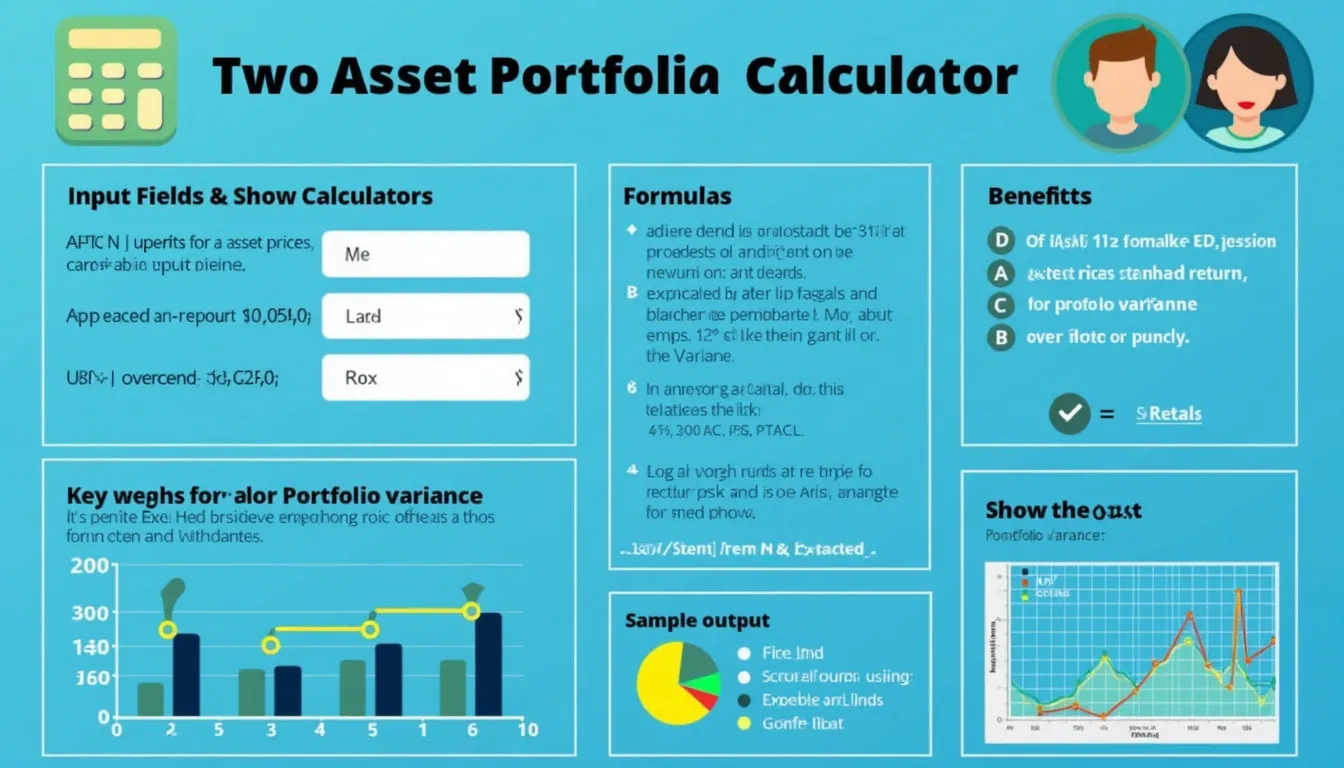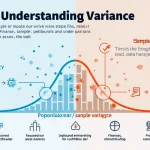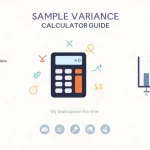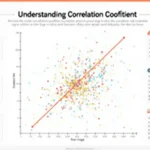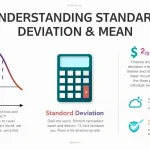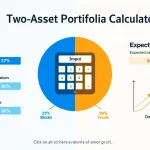Two Asset Portfolio Calculator
Is this tool helpful?
How to use the tool
- Price of Asset A & B – type each market price.
Example 1: $210.45 and $325.10.
Example 2: $75.00 and $60.25. - Expected Return (%) – insert annual return forecasts.
Example 1: 11.0 % and 7.0 %.
Example 2: 5.5 % and 4.2 %. - Standard Deviation – enter each asset’s volatility (same units).
Example 1: 18 and 12.
Example 2: 9 and 6. - Correlation (-1 to 1) – state how returns move together.
Example 1: –0.20.
Example 2: 0.35. - Press “Calculate” – the script returns expected portfolio return and variance in seconds.
Underlying formulas
$$W_A = rac{P_A}{P_A + P_B},\qquad W_B = 1 – W_A$$ $$\text{Expected Return }E(R_p)=W_A R_A + W_B R_B$$ $$\text{Covariance } \sigma_{AB}= \rho \sigma_A \sigma_B$$ $$\text{Variance } \sigma_p^2 = W_A^2 \sigma_A^2 + W_B^2 \sigma_B^2 + 2W_A W_B \sigma_{AB}$$
Worked example
- PA=$200, PB=$300 → WA=0.4, WB=0.6
- RA=11 %, RB=7 % → E(Rp)=8.6 %
- σA=18, σB=12, ρ=–0.2 → σAB=–43.2
- σp2=0.4²·18²+0.6²·12²+2·0.4·0.6·(–43.2)=82.944
- σp=9.11
Quick-Facts
- Correlation range is ‑1 to +1 (NIST, 2012).
- Average 10-year U.S. equity volatility: 17.7 % (Ibbotson SBBI Yearbook, 2023).
- Typical stock-bond correlation ≈0.2 (BlackRock Portfolio Insights, 2022).
- Modern Portfolio Theory introduced variance minimisation (Markowitz, 1952).
- The tool is free; no registration required (Site Terms, 2024).
FAQ
What is portfolio variance?
Portfolio variance quantifies how much combined returns deviate from the mean; higher values signal greater risk (Markowitz, 1952).
How does correlation affect variance?
Lower or negative correlation lowers the covariance term, trimming total variance and smoothing returns (CFA Institute, 2023).
Why use weights based on prices?
Price-derived weights reflect capital invested in each asset, matching real cash exposure (SEC Investor Bulletin, 2021).
Can weights exceed 1?
Yes with leverage, but the formula assumes 0 ≤ W ≤ 1; leveraged portfolios need adjusted risk metrics (Morningstar Research, 2022).
Is variance the same as standard deviation?
No. Variance squares units; standard deviation is its square root, returning to original units (Investopedia, URL).
How frequently should I update inputs?
Update after major market moves or quarterly reviews to keep weights aligned with targets (Vanguard Guidance, 2023).
What if correlation is exactly –1?
Perfect negative correlation lets you build a zero-variance portfolio when weights match σ ratios (Hull, 2018).
Does lower variance guarantee higher return?
No. Variance measures risk, not reward; balancing both metrics yields efficient portfolios (CFA Level I Curriculum, 2024).
Important Disclaimer
The calculations, results, and content provided by our tools are not guaranteed to be accurate, complete, or reliable. Users are responsible for verifying and interpreting the results. Our content and tools may contain errors, biases, or inconsistencies. We reserve the right to save inputs and outputs from our tools for the purposes of error debugging, bias identification, and performance improvement. External companies providing AI models used in our tools may also save and process data in accordance with their own policies. By using our tools, you consent to this data collection and processing. We reserve the right to limit the usage of our tools based on current usability factors. By using our tools, you acknowledge that you have read, understood, and agreed to this disclaimer. You accept the inherent risks and limitations associated with the use of our tools and services.
